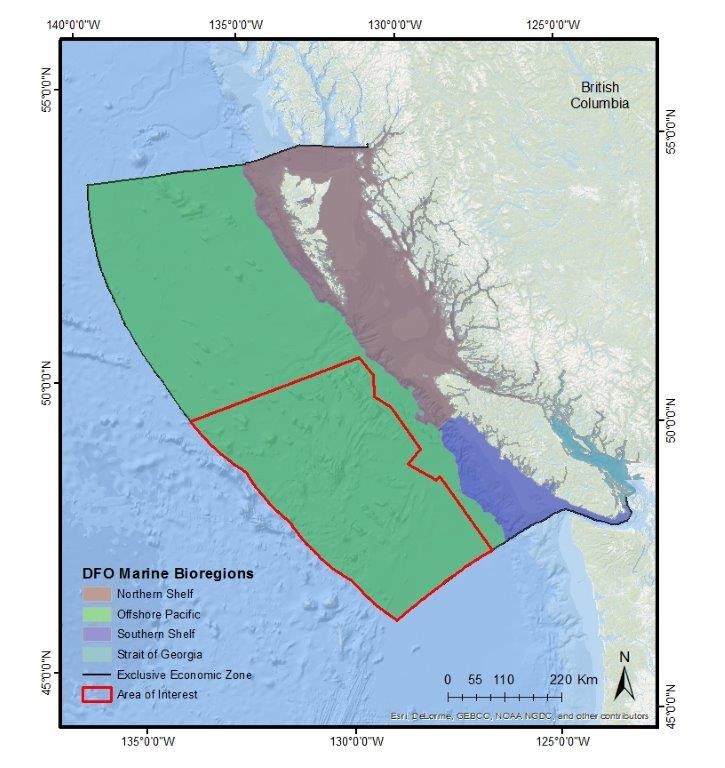Science Response 2019/011
Biophysical and Ecological Overview of the Offshore Pacific Area of Interest (AOI)
Context
Canada’s Oceans Act states that “conservation, based on an ecosystem approach, is of fundamental importance to maintaining biological diversity and productivity in the marine environment”. This act provides the legislative framework for an integrated ecosystem approach to management in Canadian oceans, particularly in areas considered ecologically or biologically significant. Ecologically or biologically significant areas (EBSAs) are areas in need of enhanced management that supercede the management needs of individual species. DFO has developed guidance for the identification of EBSAs (DFO 2004, 2011), and has endorsed the scientific criteria of the Convention on Biological Diversity (CBD) for identifying ecologically or biologically significant marine areas as defined in Annex I of Decision IX/20 of its 9th Conference of Parties (UNEP/CBD, 2008).
In 2015 Canada adopted complementary international and domestic 2020 Biodiversity Goals and Targets. Both targets (Aichi Target 11 and Canada’s Target 1) call for the conservation of 10% of coastal and marine areas by 2020. The Government of Canada recently identified an interim target of 5% protection by 2017. Under the Oceans Act, Fisheries and Oceans Canada (DFO) is authorized to provide protection to areas of the oceans and coasts through the establishment of MPAs, where the identification of an Area of Interest (AOI) is the first step in this process. The designation of new Marine Protected Areas (MPAs) in Canadian waters has been identified as part of the national strategy to meet these targets.
The identification of EBSAs in the Canadian Pacific Region serves as a key component of the knowledge base for:
- regional development activities and marine use planning;
- the development of Canada’s network of marine protected areas (MPAs) under the Oceans Act; and
- facilitating the implementation of DFO’s sustainable fisheries framework under the Fisheries Act.
On May 24, 2017, following the conclusion of a regional Area of Interest selection process, the southern portion of the Offshore Pacific Bioregion was announced as an Area of Interest (AOI) for potential MPA establishment. The area selection was informed by Identification of Ecologically and Biologically Significant Areas (EBSAs) in Canada’s Offshore Pacific Bioregion (Ban et al., 2016; DFO 2016a). Currently seamounts and hydrothermal vents EBSAs, and their associated ecosystems, have been identified as an interim conservation objective for this area. To ensure consistency with other MPA planning processes in the Northern Shelf Bioregion, the continental slope is not considered within the boundary of the Offshore Pacific Bioregion and is instead considered part of the Northern and Southern Shelf Bioregions.
This report provides detailed information on the key physical and biological oceanographic characteristics; predominant, unique habitat features; and significant species within the AOI, as they pertain to known EBSAs and their linkages to other key ecosystem components and processes. A review of this scientific knowledge may serve to highlight additional conservation priorities.
Furthermore, the biophysical and ecological overview may assist in formulating and/or refining conservation objectives, delineating the proposed MPA boundary (and zones if required), and contribute to completing an ecological risk analysis to inform the development of the regulatory approach for the MPA. The information contained within will also inform subsequent advice on monitoring protocols and strategies, identification of information gaps requiring further research, and the development of a management plan for the area.
Areas adjacent to the AOI may need to be considered to capture the necessary breadth and scope of the various components of the ecosystem. Therefore, given the geographic scale at which scientific information is currently collected and reported, the study area that has been deemed appropriate for the Offshore Area of Interest biophysical and ecological overview is displayed in Figure 1.

Figure 1. Offshore Area of Interest (AOI) in the Offshore Pacific Bioregion and the DFO marine bioregions.
The Oceans Management program of the Ecosystems Management Sector has requested DFO Science to provide advice and supporting documents to inform the Offshore Pacific AOI Marine Protected Area Process.
This Science Response results from the Science Response Process of October 2017 on the Biophysical and Ecological Overview of the Southern Portion of the Offshore Bioregion Area of Interest (AOI). It is based on the specific objectives outlined below:
- Evaluate, describe and map, where possible the key biophysical and ecological features of the study area, including:
- predominant and/or unique physical and biological oceanographic characteristics;
- predominant, unique, and/or sensitive habitat features; and
- ecologically, socially/culturally and/or commercially significant species; depleted species; and marine mammals and birds
Where appropriate, identify relevance of the study area to the life histories of species of interest, species distribution and abundance (and status and trends where available), and the local abiotic and biotic factors influencing these.
- Identify known sensitivities, resilience and recoverability of habitats and species of interest within the study area.
- Identify key uncertainties and knowledge gaps as it pertains to the current understanding of the existing environment and species of interest within the study area, and recommend measures to address these gaps, where possible.
- Where appropriate, based on the best available science, describe the area that each ecosystem components/features covers.
Accessibility Notice
This document is available in PDF format. If the document is not accessible to you, please contact the Secretariat to obtain another appropriate format, such as regular print, large print, Braille or audio version.
- Date modified: